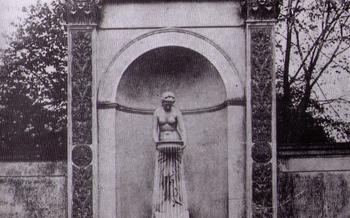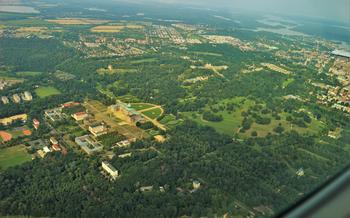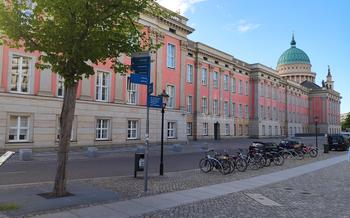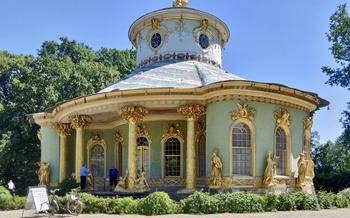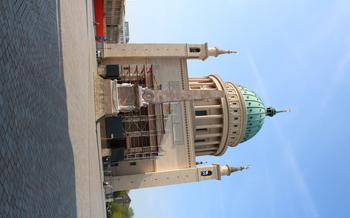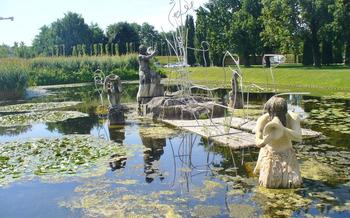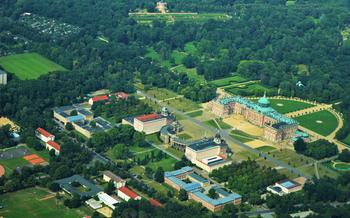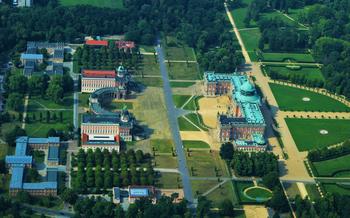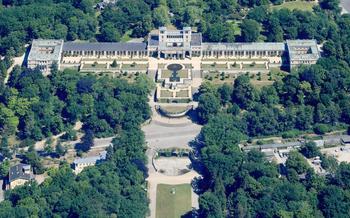
Sanssouci Palace
- Sanssouci Palace: A Symbol of Prussian Splendor
- Exploring the Enchanting Park:
- A Glimpse into Frederick the Great's Life
- Unveiling the Palace's Interior
- Walking in the Footsteps of Royalty
- Discovering the Picture Gallery
- Strolling Through the Marble Terraces
- Exploring the New Palace
- Unveiling the Chinese Teahouse
- Exploring the Orangery Park
- Enjoying a Picnic in the Park
Sanssouci Palace: A Symbol of Prussian Splendor
Nestled amidst the picturesque gardens of Potsdam, Sanssouci Palace stands as a testament to the grandeur and opulence of the Prussian monarchy. Built in the 18th century by Frederick the Great, this magnificent palace embodies the essence of the Rococo style, showcasing intricate architectural details, lavish interiors, and an unparalleled fusion of art, nature, and royalty.
As a UNESCO World Heritage Site, Sanssouci Palace holds immense historical significance. It served as a summer residence for the Prussian royal family, offering a sanctuary of tranquility and leisure away from the bustling court life of Berlin. Today, it remains a beloved symbol of German cultural heritage, attracting visitors from around the world who come to marvel at its splendor and immerse themselves in its rich history.
The palace's architectural masterpiece, designed by Georg Wenzeslaus von Knobelsdorff, seamlessly blends French and Italian influences. Its elegant façade, adorned with delicate stucco reliefs and intricate carvings, reflects the refined taste of Frederick the Great. The palace's interiors, equally impressive, feature opulent state rooms adorned with exquisite furnishings, paintings, and decorative elements that showcase the artistry and craftsmanship of the era.
Among the must-see highlights of Sanssouci Palace are the grand Marble Hall, with its dazzling white marble walls and intricate ceiling frescoes; the sumptuous Golden Gallery, adorned with gilded stuccowork and shimmering chandeliers; and the intimate Concert Room, where Frederick the Great himself entertained guests with musical performances. Each room tells a unique story, offering a glimpse into the extravagant lifestyle and refined sensibilities of the Prussian court.
Exploring the Enchanting Park:
Overview of the Park's Layout and Design:
The park surrounding Sanssouci Palace is a masterpiece of landscape architecture, designed by Georg Wenzeslaus von Knobelsdorff. It seamlessly blends formal gardens with natural landscapes, creating a harmonious and picturesque setting. Visitors are greeted by a grand entrance, leading to a central axis that runs through the park, connecting the palace with the Orangery and the New Palace. Along this axis, visitors will encounter intricate flowerbeds, meticulously trimmed hedges, and shimmering fountains.
Highlights of the Park, Including Sculptures and Water Features:
The park is adorned with an array of sculptures and water features that enhance its beauty and grandeur. Notable sculptures include the "Dying Gladiator" by Antonio Canova, the "Apollo of Belvedere," and the "Three Graces." These works of art are strategically placed throughout the park, providing a sense of harmony and balance to the landscape. The park's water features are equally impressive, with cascading fountains, tranquil ponds, and babbling brooks creating a soothing and serene atmosphere.
The Significance of the Park as a UNESCO World Heritage Site:
In 1990, the Sanssouci Park was designated as a UNESCO World Heritage Site, recognizing its outstanding universal value. The park is a testament to the artistic and cultural achievements of the 18th century and serves as a reminder of the rich history of Prussia. Its inclusion on the World Heritage List ensures its protection and preservation for future generations to appreciate.
Tips for Navigating and Exploring the Park Efficiently:
To make the most of your visit to Sanssouci Park, it's essential to plan your route and prioritize the areas you want to see. The park is vast, and it can be easy to get overwhelmed. Start by visiting the palace and its immediate surroundings. Then, explore the park's different sections, such as the Orangery Park, the New Palace Gardens, and the Marble Terraces. Take advantage of the park's many paths and trails, allowing you to discover hidden corners and enjoy the tranquility of the natural surroundings.
A Glimpse into Frederick the Great's Life
Frederick the Great, a figure renowned for his military prowess and enlightened rule, played a pivotal role in the construction and development of Sanssouci Palace. His vision for the palace extended beyond its physical form, as it also reflected his personal interests and beliefs. Frederick was a passionate patron of the arts and philosophy, and he transformed Sanssouci into a haven for intellectual pursuits. He surrounded himself with philosophers, artists, and musicians, creating a vibrant cultural atmosphere within the palace walls.
Frederick's passion for architecture and design is evident in the unique features of Sanssouci Palace. He took an active role in overseeing the palace's construction, ensuring that it aligned with his artistic sensibilities. The Rococo style of the palace, characterized by its intricate ornamentation and graceful curves, reflects Frederick's love of beauty and elegance. The palace's interior was adorned with exquisite furnishings, paintings, and sculptures, all carefully selected by Frederick to create a harmonious and sophisticated living space.
Frederick's reign marked a period of significant transformation for Prussia. He implemented progressive reforms, modernized the army, and expanded Prussia's territories. His enlightened rule earned him the title "Frederick the Great," and he became a symbol of Prussian power and prestige. Sanssouci Palace stands as a testament to Frederick's legacy, embodying his vision of an enlightened monarchy and his enduring impact on Prussian history.
One intriguing anecdote about Frederick is his love for dogs. He was known to have a particular fondness for greyhounds, and he often took them with him on his travels. It is said that Frederick even had a special cemetery built for his beloved dogs within the park grounds, demonstrating his deep affection for his canine companions.
Unveiling the Palace's Interior
The interior of Sanssouci Palace is as captivating as its exterior, showcasing a blend of elegance and opulence. Step inside and prepare to be awestruck by the grand state rooms, each adorned with intricate details and exquisite furnishings.
One of the highlights is the Concert Room, where Frederick the Great hosted intimate musical performances. Its walls are adorned with delicate stuccowork and graceful mirrors, creating an atmosphere of refined elegance. The Voltaire Room is another must-see, named after the renowned French philosopher and writer who was a frequent guest of Frederick. This room features a collection of Voltaire's works and personal belongings, offering a glimpse into their intellectual friendship.
Admire the Marble Hall, a testament to the palace's grandeur. Its gleaming marble floors, intricate carvings, and majestic chandeliers create a sense of awe and wonder. Don't miss the Picture Gallery, home to an impressive collection of paintings by renowned artists such as Rubens, Caravaggio, and Watteau. These masterpieces adorn the walls, inviting visitors to explore the rich history of European art.
When capturing the beauty of the palace's interior, remember to respect the designated photography areas and avoid using flash to preserve the artwork. Take your time to soak in the ambiance and capture the essence of each room, allowing the palace's grandeur to shine through your lens.
Walking in the Footsteps of Royalty
The Sanssouci Palace served as a summer residence for Prussian royalty, immersing visitors in the grandeur and opulence of the Prussian court. Picture lavish banquets, elegant balls, and intimate gatherings within the palace's opulent halls. Imagine royalty strolling through the picturesque park, admiring the meticulously manicured gardens and engaging in leisurely pursuits.
Notable Royal Figures:
- Frederick the Great: The palace's original owner and one of Prussia's most renowned monarchs, known for his military prowess and cultural patronage.
- Frederick William IV: A romantic soul who transformed the palace into a sanctuary for art and music, hosting concerts and theatrical performances.
- Empress Augusta: Frederick William IV's wife, who played a significant role in shaping the park's design and introducing exotic plants from around the world.
Stories and Legends:
- The palace's construction was shrouded in secrecy, with Frederick the Great overseeing its progress incognito, earning it the nickname "Little Folly."
- Frederick the Great's beloved dogs had their own dedicated cemetery within the park, a testament to his deep affection for his canine companions.
- Legend has it that the ghost of Frederick the Great still roams the palace's halls, keeping watch over his beloved creation.
Discovering the Picture Gallery
Within the confines of the Sanssouci Park, the Picture Gallery stands as a testament to the artistic patronage of Frederick the Great. This remarkable structure, designed by the renowned architect Georg Wenzeslaus von Knobelsdorff, houses an impressive collection of paintings that transport visitors to the heart of the European art scene.
The gallery's walls are adorned with masterpieces by renowned artists of the 17th and 18th centuries, including Rubens, van Dyck, and Caravaggio. Visitors can feast their eyes on breathtaking landscapes, intimate portraits, and powerful religious scenes, each brushstroke a testament to the artistic brilliance of the era.
Among the highlights of the collection is Caravaggio's "The Entombment," a haunting depiction of Christ's burial. The painting's dramatic lighting and poignant expressions evoke a profound sense of grief and loss. In contrast, Rubens' "The Rape of the Daughters of Leucippus" is a vibrant and dynamic work that captures the energy and movement of the mythological scene.
The Picture Gallery is not merely a repository of artistic treasures; it is also a testament to Frederick the Great's refined taste and his desire to create a space for contemplation and inspiration. Whether you are an art enthusiast or simply appreciate the beauty of a well-curated collection, a visit to the Picture Gallery is an absolute must.
To enhance your visit, consider joining a guided tour led by knowledgeable art historians who can provide insights into the paintings' history, symbolism, and artistic techniques. Additionally, take advantage of the gallery's audio guides, which offer a self-paced tour with in-depth commentary on selected works.
As you wander through the Picture Gallery, let the masterpieces transport you to a different time and place. Immerse yourself in the stories depicted on canvas, and allow the beauty of these works to ignite your imagination and enrich your understanding of art history.
Strolling Through the Marble Terraces
The Marble Terraces: A Regal Promenade with Panoramic Views
The Marble Terraces, a magnificent architectural feat, form an integral part of the Sanssouci Palace complex. Designed by Georg Wenzeslaus von Knobelsdorff, these terraces serve as a grand promenade, offering breathtaking views of the park and surrounding gardens. Constructed using exquisite Italian marble, the terraces exude an air of elegance and grandeur.
As you ascend the terraces, you will be greeted by a series of intricately carved balustrades, statues, and urns that adorn the staircases and landings. These decorative elements add a touch of refinement to the overall design.
Once you reach the upper terrace, you will be rewarded with panoramic vistas of the park's meticulously landscaped gardens. The lush greenery, vibrant flowerbeds, and shimmering fountains create a picturesque landscape that will captivate your senses.
Take a leisurely stroll along the terraces, enjoying the fresh air and admiring the stunning views. Whether you choose to wander alone or in the company of friends and family, the Marble Terraces offer a serene and tranquil setting for a truly memorable experience.
Tips for Enjoying the Marble Terraces:
-
Arrive early in the morning or late in the afternoon to avoid crowds and capture the best light for photography.
-
Bring a camera to capture the stunning views and architectural details of the terraces.
-
Wear comfortable shoes, as you will be doing a fair amount of walking.
-
Take your time to explore the terraces and discover the hidden gems, such as the intricate carvings and sculptures.
-
Relax on one of the benches and enjoy the tranquility of the surroundings.
Exploring the New Palace
The New Palace, also known as the Neues Palais, stands as a testament to the grandeur and ambition of Frederick the Great. Constructed between 1763 and 1769, this opulent palace served as a grand residence for the Prussian court and a symbol of Prussia's growing power.
In stark contrast to the intimate charm of Sanssouci Palace, the New Palace exudes an air of majestic extravagance. Its sprawling Baroque facade, adorned with intricate carvings and sculptures, hints at the lavishness that awaits within.
Upon entering the New Palace, visitors are greeted by a breathtaking enfilade of state rooms, each more opulent than the last. Marble floors, glittering chandeliers, and walls adorned with exquisite tapestries create a sense of awe-inspiring grandeur.
Highlights of the palace's interior include the opulent Marble Hall, with its soaring columns and intricate ceiling frescoes, and the Grand Gallery, a stunning ballroom adorned with mirrors and crystal chandeliers. The palace also houses an impressive collection of paintings, sculptures, and decorative arts, showcasing the refined taste and patronage of the Prussian court.
For those seeking a comprehensive exploration of Prussian history and architecture, a visit to the New Palace is an absolute must. Its grandeur and opulence offer a glimpse into the lavish lifestyle of the Prussian monarchy and the artistic and cultural achievements of the era.
Unveiling the Chinese Teahouse
Nestled amidst the tranquil gardens of Sanssouci Park, the Chinese Teahouse stands as a testament to the exotic fascination that captivated European royalty in the 18th century. Built in 1755-1764, this exquisite pavilion was designed by Johann Gottfried Büring and inspired by the architectural styles of the Far East.
The teahouse's exterior is a marvel of intricate details, featuring curved roofs adorned with colorful tiles, delicate woodwork, and ornate carvings that evoke a sense of distant lands. Inside, visitors are greeted by an elegant and serene atmosphere, with pastel-colored walls, Chinese-inspired furnishings, and a collection of exquisite porcelain.
The Chinese Teahouse served as a place of relaxation and entertainment for Frederick the Great and his guests, who would gather here to savor fine teas, engage in philosophical discussions, and enjoy musical performances. It was also a symbol of the king's cosmopolitan tastes and his appreciation for different cultures.
Today, the Chinese Teahouse remains a popular attraction for visitors to Sanssouci Park. Step inside and let your imagination transport you to a bygone era, where the air was filled with the aroma of exotic teas, the sound of laughter, and the whispers of royal secrets.
Tips for capturing the essence of the Chinese Teahouse in your photos:
- Experiment with different angles to capture the unique architectural features of the teahouse, such as the curved roofs and intricate carvings.
- Use natural light to your advantage, as the teahouse's interior is often bathed in soft, diffused light that creates a magical ambiance.
- Include elements of the surrounding gardens in your shots to convey the teahouse's harmonious relationship with nature.
- Take advantage of the teahouse's colorful tiles and porcelain collection to add pops of color and interest to your photographs.
Exploring the Orangery Park
Immerse yourself in the tranquil beauty of the Orangery Park, an enchanting extension of the Sanssouci Park.
Designed as a picturesque backdrop to the Orangery Palace, the Orangery Park boasts a harmonious blend of formal gardens, manicured lawns, and tranquil water features. Stroll along the tree-lined paths and discover an array of sculptures, fountains, and decorative elements that adorn this serene oasis.
The park's centerpiece is the Orangery Palace itself, a magnificent structure known for its stunning architecture and collection of exotic plants. Admire the palace's elegant façade, adorned with intricate carvings and delicate ornamentation. Take a moment to explore the palace's interior, where you can marvel at the collection of citrus trees and tropical plants that fill the grand hall.
Among the park's many highlights is the Große Fontäne, a magnificent fountain that cascades into a tranquil pool, creating a mesmerizing display of water and light. Capture the fountain's grandeur in your photos, as it reflects the surrounding greenery and the palace's imposing architecture.
Discover hidden gems such as the Dragon Fountain, a whimsical sculpture that delights visitors with its intricate details and playful design. Admire the beauty of the rose garden, where vibrant blooms fill the air with their sweet fragrance.
The Orangery Park is a haven of tranquility, where you can escape the hustle and bustle of everyday life and immerse yourself in the serene beauty of nature. Whether you're seeking a leisurely stroll, a romantic picnic, or simply a moment of peaceful contemplation, the Orangery Park offers a truly enchanting experience.
Enjoying a Picnic in the Park
The vast expanse of the park at Sanssouci provides ample opportunities for visitors to enjoy a leisurely picnic. Designated picnic areas are scattered throughout the grounds, inviting visitors to spread out their blankets and indulge in a delightful meal amidst the beautiful surroundings.
To enhance your picnic experience, consider packing a basket filled with fresh fruits, artisanal cheeses, crusty bread, and a chilled bottle of wine. Alternatively, you can purchase refreshments from the nearby cafes and kiosks. As you savor your picnic, take in the tranquil atmosphere and the beauty of the park's landscaping.
Picnicking in the park is a wonderful way to connect with nature and enjoy a relaxing break from sightseeing. Remember to follow the park's guidelines and etiquette, such as properly disposing of waste and respecting the surrounding environment. Embrace the opportunity to create unforgettable memories as you dine in the heart of this UNESCO World Heritage Site.
